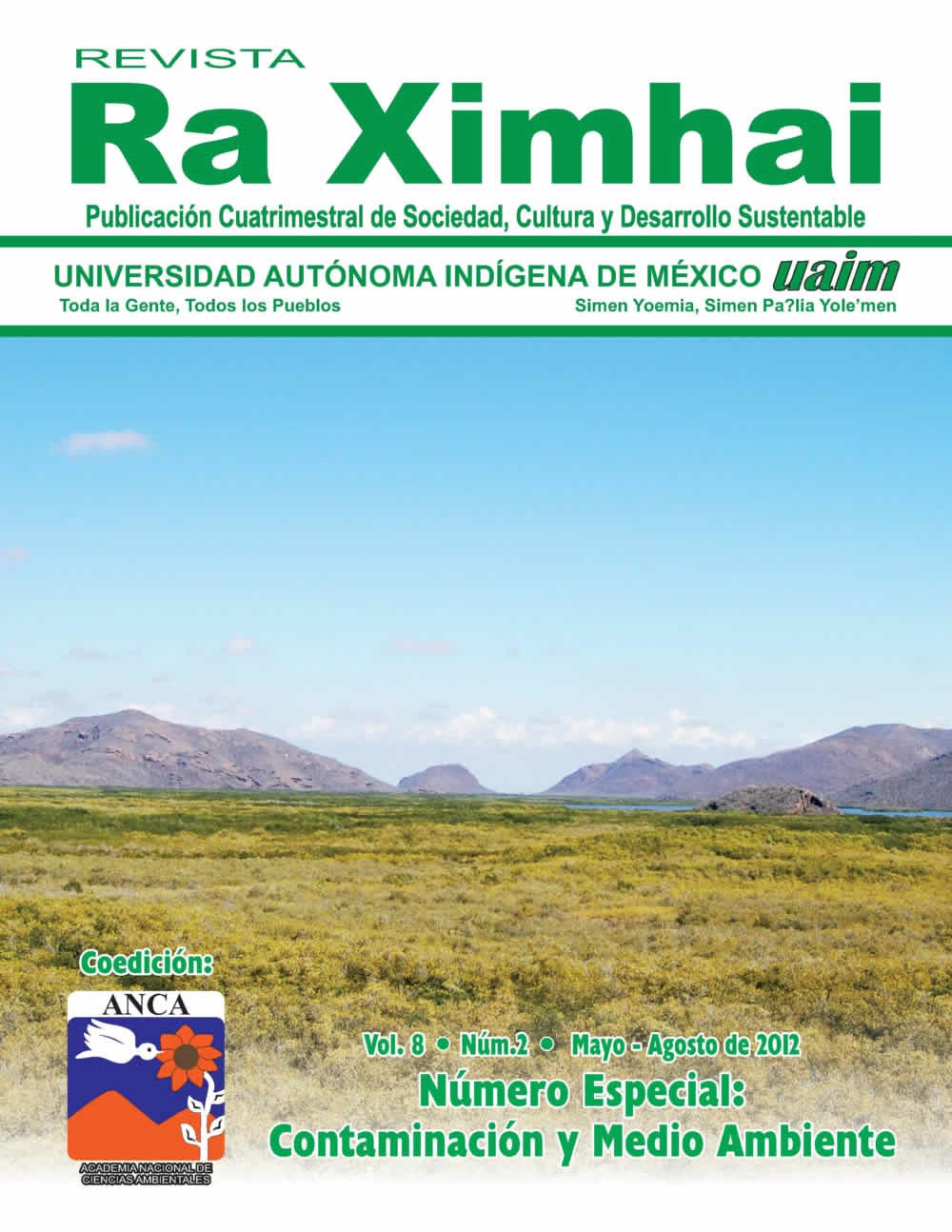Environmental impact assessment on mangrove seedling morphometry by crude oil
DOI:
https://doi.org/10.35197/rx.08.02.e.2012.08.grKeywords:
oil, vegetation, mangroveAbstract
A study was conducted to examine the cumulative effects after an oil spill and to assess the impact of oil on a typical zoning with seedlings of Rhizophora mangle, Laguncularia racemosa and Avicennia germinans under controlled conditions of ambient temperature, humidity, hydroperiod, salinity and microtopography in a greenhouse. It is relevant to mention that this study had a stabilization phase of 40 days and then the oil spill was carried out on the experiment which lasted 183 days; The negative effects found in the three species mentioned above have been located in terms of height and diameter increase, presenting lower diameter rates in the DCPC (0.0043, 0.0037 and 0.0031 mm/day), compared to the DT (0.067, 0.0052 and 0.0044 mm/day). Where the greatest effect was observed in Rhizophora mangle presenting a decrease in diameter growth, due to the immediate impact and the longer residence time of the crude oil.
In the case of height growth, the effects of the oil were more evident for Rhizophora mangle decreasing by 50% and in Avicenniagerminans by 58%, compared to the reference seedlings. This last species is affected due to the concentration of the hydrocarbon in the sediment by percolation, stimulated by the lower amplitude and frequency of flooding, evidenced by the increase in alkalinity in the sediment, derived from the hydrophobicity of petroleum compounds, in Rhizophora mangle and Avicennia germinas (8.1 ± 0.04 and 8.4 ± 0.47), unlike DT (5.8 ± 0.4 and 7.0 ± 0.2).
Downloads
References
Agraz-Hernández, C. M.; Osti-Sáenz, J.; Jiménez-Zacarías, J.; García- Zaragoza, C.; Arana Lezama, R.; Chan Canul, E.; González-Duran, L.; Palomo-Rodríguez, A. 2007. Restauración con manglar: Criterios y técnicas hidrológicas, de reforestación y forestación. 1era. edición. Universidad Autónoma de Campeche, Comisión Federal de Electricidad, Comisión federal de Electricidad, Comisión Nacional Forestal. ISBN: 968-5722-54-4. 132 pp.
Calva, L.G.B. 1997. Hidrocarburos Fósiles en Lagunas Costeras. Contactos, 3ra. Época,21:16-22.
Cintrón, G. & Schaeffer-Novelli., Y. 1984. Características y desarrollo estructural de los manglares de norte y sur de América. CienciaInteramericana. Vol. 25 (1-4): 4-15.
Contreras, F.E. 1986. Ecosistemas Costeros Mexicanos. CONABIO-UAMI. 415 pp.
Draper NR & Smith H. 1998. Applied Regression Analysis(3rd edition). New
York: Wiley.
Duke, N. C. and K.A. Burns. 1999. Fate and effects of oil and dispersed oil on mangrove ecosystems in Australia. Australian Institute of Marine Science and CRC. Research Centre. 17 pp.
Duke, N. C. and Z.S. Pinzon. 1992.Aging Rhizophoraseedligs from leaf scar nodes: a method for studying recruitment and growth in tropical mangrove forests. Biotropica, 24(2).
Duke,N.C.; W.R., y Williams, W.t. 1981. Growth ring and rainfall correlation in a mangrove tree of the genus Diospyros( Ebenacea). Aust. S.Bot..29: 135-42.
Gupta, G. and Y. J. Lin. 1993. Toxicity ofaquos-leachate through sand-clay columns. J. Environ. Sci. Health. A 28(4):933-940.
Gutiérrez C., M. C. Zavala C. 2002. Rasgos hidromorficos de suelos tropicales contaminados con hidrocarburos. Terra Latinoamericana. 20:101-111.
Klekowski,Jr.; E.J.; Corredor, J.E.; Morell,
J.M. and DelCastillo,C.A. 1994. Petroleum pollution and mutation in mangroves. Marine Pollution Bulletin. 28: 166-169.
Lugo, A.E. 1980. Mangrove ecosystems: succecional or stady state. Biotropica,12: 67-72.
Martínez M., V.E. y, F. López S. 2001. Efecto de hidrocarburo en las propiedades físicas y químicas de suelo arcilloso. Terra. 19: 9-17.
Neff, M.F. 1979. Polycyclic Aromatic Hydrocarbons in aquatic environment.
Sources, Fates and Biological Effects. Applied Science Publisher. U.K. 262 pp.
Ponte, A.C.E.; Fonseca, I.A.Z. & Claro,
M.C.A. 1990. Produção de serapilheiraem bosque impactado por petróleo. In: Simpósio sobre Ecossistemas da Costa Sul e Sudeste Brasileira.Síntese dos Conhecimentos, Cananéia, São Paulo: ACIESP, v2, 241-253 pp.
Proffitt E.C. y Devlin D.J. 1998. Are there cumulative effects in red mangroves from oil spill during seedling and sapling stages. Ecol. Appl. Vol.8: 121-127.
Rodrigues, F.O.; Moura, D.O. &Lamparelli,
C.C. 1999. Environmentalimpact in mangroveecosystems Sao Paolo, Brazil. In: Ecosistemas de Manglar en América Tropical. A. Yañez-Arancibia y A.L. Lara- Domínguez (eds).Instituto de Ecología
A.C. México, UICN/ ORMA, Costa Rica, NOAA/ NMFS Silver Spring MD, USA. 380 pp.
Suprayogi B. y Murray F. 1999. A field experiment of the physical and chemical effects of two oils on mangroves. Environ. Exp. Bot. 42, 221-229.
Totsche, K.U., J. Danzer and I. Kogel- Knaber. 1997. Dissolved organic matter- enchanced retention of polycyclic aromatic hydrocarbons soil miscible displacement experiments. J. Environ. Qual. 26:1090-1
Downloads
Published
How to Cite
Issue
Section
License
Copyright (c) 2012 G.C. Requena Pavón, C. M. Agraz Hernández, A. Vazquez Botello, J. Osti Saénz, J.E. Reyes Castellanos , C. Chan Keb , C. García Zaragoza

This work is licensed under a Creative Commons Attribution-NonCommercial 4.0 International License.
Usted es libre de:
- Compartir — copiar y redistribuir el material en cualquier medio o formato
- Adaptar — remezclar, transformar y construir a partir del material
- La licenciante no puede revocar estas libertades en tanto usted siga los términos de la licencia
Bajo los siguientes términos:
- Atribución — Usted debe dar crédito de manera adecuada , brindar un enlace a la licencia, e indicar si se han realizado cambios . Puede hacerlo en cualquier forma razonable, pero no de forma tal que sugiera que usted o su uso tienen el apoyo de la licenciante.
- NoComercial — Usted no puede hacer uso del material con propósitos comerciales .
- No hay restricciones adicionales — No puede aplicar términos legales ni medidas tecnológicas que restrinjan legalmente a otras a hacer cualquier uso permitido por la licencia.








